Float Fishing Michigan: Tactics For Trout, Steelhead, Salmon
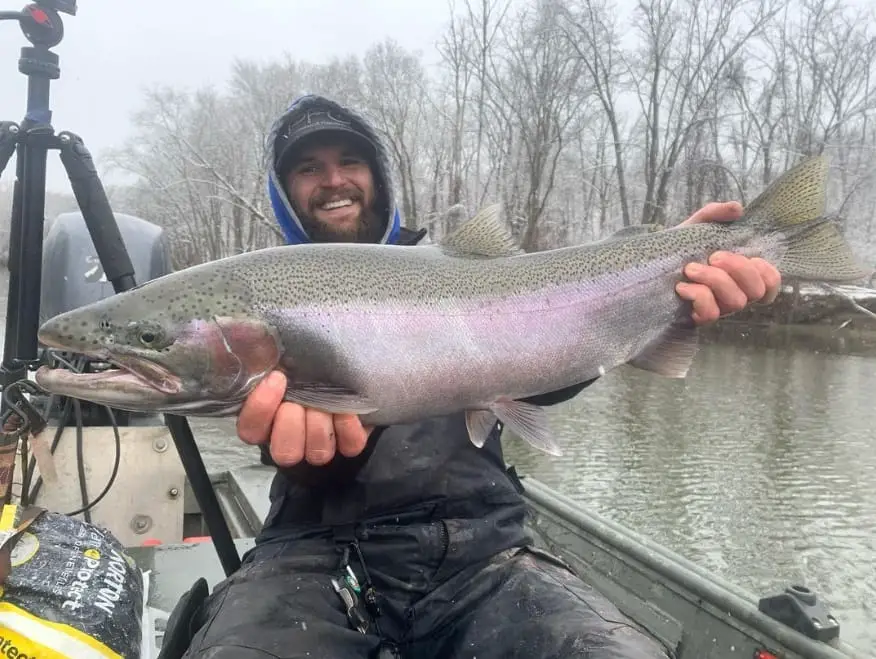
As a seasoned trout, steelhead, and salmon guide, I would argue that float fishing Michigan streams is the most effective method.
Michigan is home to numerous excellent rivers teeming with trout, steelhead, and salmon, and float fishing proves particularly effective due to the method’s ability to keep your bait suspended in the strike zone for long durations. This significantly increases the number of fish you’re likely to catch.
I have picked up various tips and tricks while teaching over a thousand anglers how to float fish, and these tips have significantly improved my client’s abilities to reel in more fish, and I’m happy to share this knowledge with you on this page.
What is float fishing?
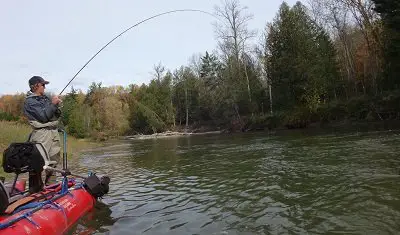
Float fishing is a method that involves suspending your bait beneath a specialized float or bobber made for river fishing, which allows the bait to drift naturally down the river for long distances with the current.
What makes float fishing so effective is the ability to suspend your bait in the strike zone for long periods of time. The float also allows the angler to detect a bite easily.
For this reason, float fishing is a widely used technique and is exceptionally effective for catching steelhead, salmon, and trout, even for beginners.
However, despite seeming simple, I’ve discovered that the key to success lies in these five aspects:
- Speed Control
- Depth Control
- Presentation
- Covering The Water
- Bait Selection
I’ll tell you this now, if you screw up any of these, you will struggle to catch fish.
What Michigan River Can You Float Fish?
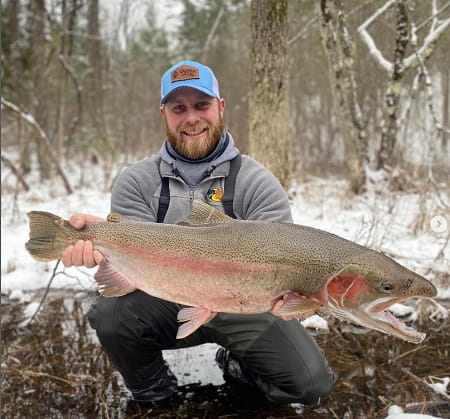
All Michigan rivers are well-suited for float fishing. It’s essential to adjust your float fishing setup to the type of water, mainly focusing on the depth and velocity of the current.
Whether the waters are fast or slow, deep or shallow, float fishing is effective for all types of rivers.
Float fishing is ideal if the water is deeper than three feet and shallower than 13 feet.
The float might scare off the fish when the water is under three feet deep, particularly if it’s very clear. In these conditions, or tiny pockets less than a few feet around, I will switch to a method known as bottom bouncing.
Some good places to try float fishing in Michigan are:
- Manistee River: The Manistee River is one of Michigan’s best places for float fishing. The river is home to numerous species, including salmon, trout, and walleye. It’s particularly renowned for its steelhead run.
- Au Sable River: The Au Sable River is a premier fly fishing destination. It’s one of the best places in the state to catch brook trout, brown trout, and rainbow trout. Float fishing is also a popular activity in this river.
- Grand River: The Grand River is the longest river in Michigan, providing ample opportunities for float fishing. It’s home to a variety of species including smallmouth bass, pike, and catfish.
- Lake St. Clair: While not a river, Lake St. Clair is worth mentioning. It’s a fantastic place for float fishing, especially for those targeting perch and smallmouth bass.
- Muskegon River: Another great spot for float fishing, the Muskegon River offers a good number of salmon, steelhead, and brown trout.
- Pere Marquette River: Famous for its salmon and steelhead runs, the Pere Marquette River is a great place to try float fishing. It’s also one of the best rivers in the state for fly fishing.
- Small and Large Streams: Michigan has hundreds more trout and steelhead streams that are great for float fishing.
Reels For Float Fishing
When preparing to float fish in Michigan, one crucial piece of equipment you’ll need is the correct type of reel. Certain reels are more suitable than others for the float fishing technique.
The most commonly used float reels for fishing under a float are centerpin reels and spinning reels.
Centerpin Reels Are Best For Float Fishing In Michigan
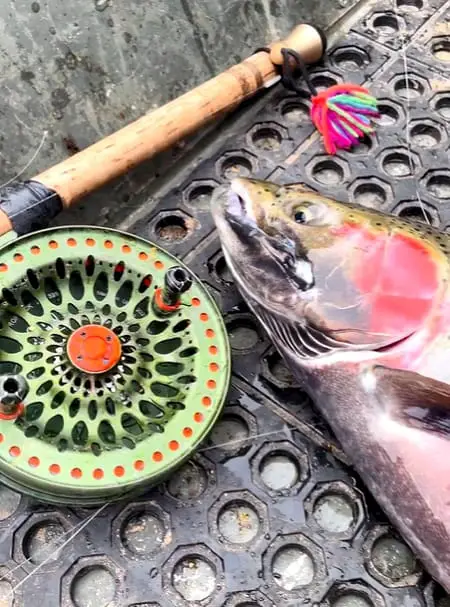
The Centerpin reel, named for the large round spool that rests on a center pin or post, is characterized by its incredibly high-quality bearings that allow free spool spin as the current pulls the float downstream.
The Centerpin reel enables very long, precise drifts without mending or feeding the line out. This significantly improves your ability to keep your bait in the strike zone longer and allows you to control your presentation and speed, thus enhancing your success rate.
Having spent around 30 years using Centerpin reels and comparing them to spinning reels and baitcasting reels, I can confidently say that the Centerpin reel is the best reel for float fishing in any river.
Spinning Reels
Spinning reels are the second-best choice for float fishing in Michigan rivers and are by far the most popular reel. I only use a spinning reel if my clients request it or if I need a multipurpose reel for other techniques.
Float Fishing Setup
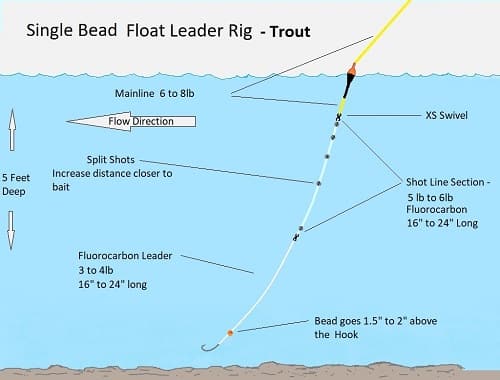
There are a few setups I use for float fishing, but the basics are simple, a float, a leader, split shots, swivels, and a hook.
I will adjust the size of the leader depending on the type of water or the type of fish. A leader for salmon is going to be much heavier than the leader for salmon.
The Leader For Float Fishing
Your choice of leader line for trout, steelhead, and salmon is critical when float fishing.
The ideal leader is thin enough to be invisible to the fish, yet strong enough to withstand the strength of larger fish without snapping.
Here’s my preferred setup after years of experimentation:
Trout Fishing Leader:
I recommend a 3 to 4-pound leader for trout for most rivers. When fishing larger trout in fast or large rivers, you might want to go to a 6-pound leader
Steelhead Fishing Leader:
- Clear Water: For clear waters and smaller rivers, a 6-pound leader (0.18mm) is ideal.
- All Water: A good all-purpose leader for steelhead is 8 pounds (0.20mm)
- Large Rivers: a 10-pound leader (0.22mm) works best in larger rivers, in rapid currents, or for sizable steelhead.
Salmon Fishing Leader:
- Clear Water: In crystal-clear water and smaller streams, a 10-pound leader (0.22mm) is best.
- All Water: For general purposes, a 12-pound leader (0.24mm) works well
- Big Rivers: A 14-pound leader (0.25mm) is the choice for fast-moving waters and large rivers.
I exclusively use fluorocarbon leaders and typically employ two sizes in my leader setup.
Ordinarily, the leader setup consists of two sections: the shot line section and the bottom section. For these, you’ll require two different leader sizes. As a general guideline, the shot-line leader should be approximately two sizes heavier than the lower leader size.
Floats: The Heart of the Technique
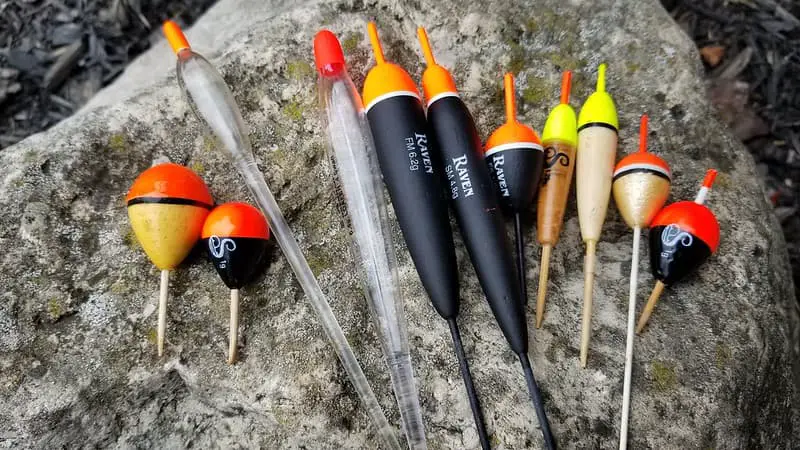
As its name implies, a float is the core of float fishing. Not all floats for Centerpin are created equal – some fail to do the job while others excel at it.
The correct float helps you manage your speed, determine your depth, and ultimately reel in more trout, steelhead, and salmon.
You should choose a float appropriate for the body of water you intend to fish in, in terms of its depth and size. My preferred floats are:
In water deeper than my rod’s length, I switch to a slip float, which, if set up correctly, lets me fish in areas even over 20 feet deep. I always use a fixed float for water that’s 3 to 10 feet deep.
- Drennan Loafer Floats: Best for clear and slow-moving water.
- Raven FM Floats: fantastic for most circumstances.
You can learn more about selecting the best floats for your float fishing by visiting my page, “5 Best Centerpin Floats.”
Split Shots / Weights
I exclusively use dark, round split shots. I don’t use shiny weights or those with removable wings.
Hooks For Float Fishing
Guides are very picky when it comes to the best hooks. The reason is that they have figured out which hooks penetrate and hold the fish on securely with the least fish coming off.
Some hooks also suck, so be sure you use a good hook like the Raven Specimen hook or the Gamakatsu Octopus hook.
Most Effective Baits For Float Fishing Michigan
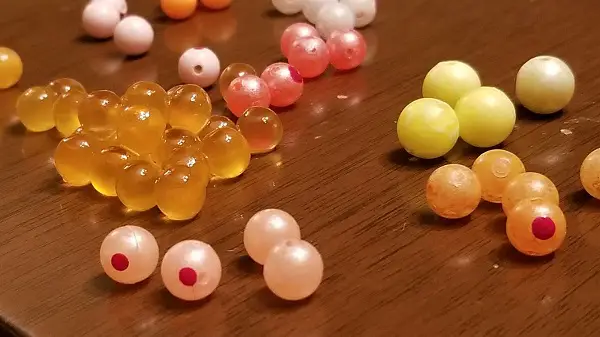
Fishermen have a myriad of baits at their disposal; however, experienced guides have identified the most effective and consistent baits. These select few are used 95 percent of the time, while less effective baits are disregarded.
I choose my baits based on the conditions, and certain times of the year or particular water conditions may render a typically effective bait useless.
Because of this, I always carry several good baits with me, and I cycle through different baits, sizes, and colors to figure out which will provoke a strike response.
Consider these baits:
- Salmon Eggs and Trout Eggs: Effective for trout, steelhead, and salmon at certain times of the year.
- Worms: Generally effective in spring but can be successful year-round.
- Artificial Flies: The types that fly fishermen use can be effective at any time of the year and sometimes are the most effective.
- Live Baits: This includes insects like crickets, hellgrammites, stoneflies, beetles, mealworms, grubs, minnows, leeches, crayfish, etc.
- Artificial Baits: This includes plastic imitations of the above baits and baits like Powerbait Doughs.
Tips For Ten Times More Fish
When it comes to float fishing, there’s a simple formula for success. If you mess up even a portion of it, you’ll struggle to catch fish.
So, let me explain this so you can understand and start reeling in more fish.
If my presentation is perfect, but I use a hook that’s too big for the bait, I’ll catch less fish.
If my presentation and hook are perfect, but the leader is so thick that the fish see it, I won’t catch fish.
If my entire setup is perfect, but the speed of my bait is off, or the depth is nto right, or I stomp into the river and spook half the fish, I’ll catch fewer fish.
In other words, each part of the formula needs to be perfect, or the other parts of the formula will not be as effective, resulting in fewer fish. I see anglers make these mistakes all the time.
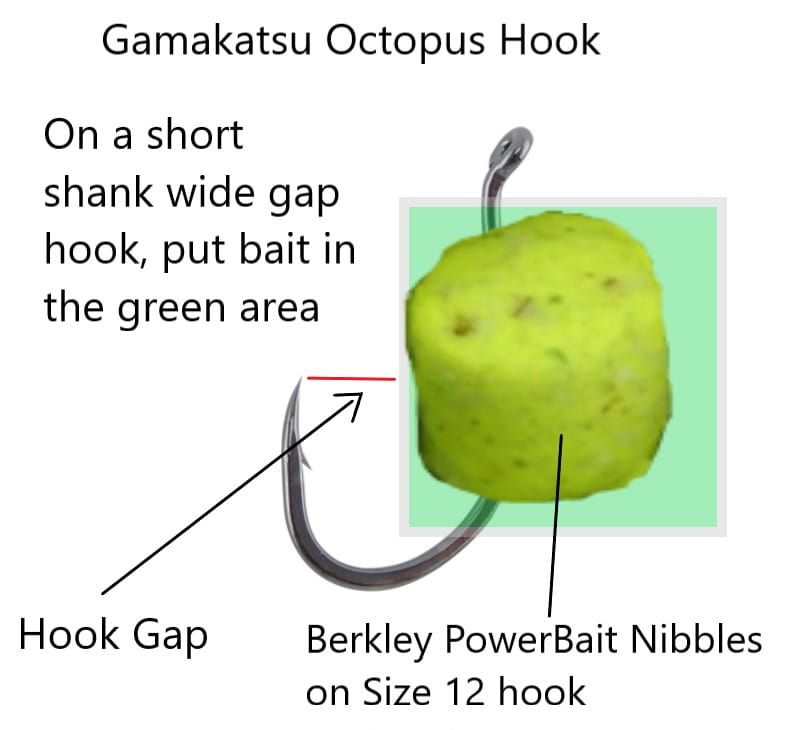
The reason my clients and other guides catch more fish is that we ensure the bait is at the right depth, and we use the right bait size and the right hook size for the conditions.
The hook size should match the bait size, and the bait size should match the fish size and the fish’s feeding behavior on that particular day.
Even the color of the bait can make a big difference. There are days when fish seem to prefer a certain color over others. Even mornings versus afternoons can call for a different color or type of bait based on the light conditions and fish activity levels.
- Control the Float Speed: The float should move at the same speed as the current or a little slower. I can achieve this by mending the line or holding the float back with a method known as trotting or checking the float. In my opinion, bait speed control is critical to catching more fish.
- Control the Bait Depth: Depending on the water conditions, I adjust the depth of the bait so it’s in the strike zone. As a general rule, the bait should be near the bottom but not touching it. See setting the hook depth.
- Choose the Right Bait: Different fish species prefer different types of bait. I understand the feeding habits of the fish I am targeting and then choose the right bait accordingly.
- Use the Correct Hook Size: The hook size should match the size of the bait. If it’s too large, the fish may get scared, and if it’s too small, the fish might swallow the hook, which is not ideal for catch and release.
- Practice Accurate Casting: Good casting skills can mean the difference between a successful day and a day without a bite. This will help you effectively cover the water, resulting in more fish.
- Keep a Low Profile: Fish can get easily spooked by movement and shadows. Keep a low profile and try not to make any sudden movements.
- Stay Vigilant: Pay close attention to the float. Sometimes, a fish bite can be very subtle, causing the float to barely move. Stay focused, set the hook on everything, and don’t miss any bites.
- Change Bait Regularly: If I am not getting any bites, I will change the bait often to determin what the fish want. Sometimes, all it takes is a different bait to trigger a bite.
Regulations For Michigan
Remember, when fishing in Michigan, following all local rules and regulations is important. Some bodies of water may have specific regulations regarding fishing methods, bait, and the type and size of fish you can keep.
Also, always remember to clean up after yourself and respect the environment.
Other Things To Consider
Besides this, don’t forget to check the local weather before heading out. Weather conditions can dramatically impact fishing success, so it’s always best to plan accordingly. Wind, rain, temperature, and barometric pressure all influence fish behavior.
Additionally, consider fishing during the early morning or late afternoon, as these are the times when fish are most active. This is especially true for many species of trout and bass, which tend to feed during these periods.
With proper planning, patience, and following the tips discussed above, you’re sure to improve your chances of a successful float fishing experience in Michigan. Happy fishing!
Want to see my float fishing leader setups and methods for each species? If so check out the following:
Tight Lines
Graham
